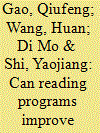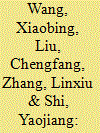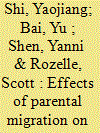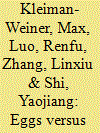|
|
|
Sort Order |
|
|
|
Items / Page
|
|
|
|
|
|
|
| Srl | Item |
| 1 |
ID:
163335


|
|
|
|
|
| Summary/Abstract |
In this paper, we attempt to evaluate the effectiveness of reading programs at improving the reading skills and academic achievement of primary school students in rural China. Using survey data on 4108 students, we find that students exhibited low levels of reading achievement, independent reading quantity, and reading confidence in the absence of any treatment. However, our results also suggest that properly designed treatments may improve the reading and academic outcomes of students. Specifically, we found that increased access to independent reading materials coupled with effective teacher training led to significant improvements in student reading skills, math test scores, and Chinese test scores. We believe that these improvements are due to changes in reading instruction and the attitudes of teachers toward reading. These findings indicate that encouraging higher reading quantity and providing high-quality reading instruction are important components for programs that seek to improve student outcomes in developing country settings.
|
|
|
|
|
|
|
|
|
|
|
|
|
|
|
|
| 2 |
ID:
121213


|
|
|
|
|
| Publication |
2013.
|
| Summary/Abstract |
The opportunity to attend college and earn a degree has increased dramatically in China. However, that does not mean that everyone has an equal opportunity. Historically, there has been well-documented systematic discrimination against minorities, women and the rural poor. The main question of this paper is whether or not this discrimination has persisted since the recent expansion of China's tertiary education system. Using a census of incoming freshmen from four tier one universities, this paper assesses if certain types of students are over-represented while other types of students are under-represented. Comparing the shares of students from different socioeconomic and ethnic backgrounds from our primary survey data with government generated census statistics, we conclude that poor, minority and rural female students are systematically under-represented. In contrast, rich, Han, urban males are dominant in college.
|
|
|
|
|
|
|
|
|
|
|
|
|
|
|
|
| 3 |
ID:
143364


|
|
|
|
|
| Summary/Abstract |
There is a great degree of heterogeneity among the studies that investigate whether computer technologies improve education and how students benefit from them – if at all. The overall goal of this study is to assess the effectiveness of computing technologies to raise educational performance and non-cognitive outcomes and identify what program components are most effective in doing so. To achieve this aim we pool the data sets of five separate studies about computer technology programs that include observations of 16,856 students from 171 primary schools across three provinces in China. We find that overall computing technologies have positive and significant impacts on student academic achievement in both math and in Chinese. The programs are found to be more effective if they are implemented out-of-school, avoiding what appear to be substitution effects when programs are run during school. The programs also have heterogeneous effects by gender. Specifically, boys gain more than girls in Chinese. We did not find heterogeneous effects by student initial achievement levels. We also found that the programs that help students learn math—but not Chinese—have positive impacts on student self-efficacy.
|
|
|
|
|
|
|
|
|
|
|
|
|
|
|
|
| 4 |
ID:
149748


|
|
|
|
|
| Summary/Abstract |
In 2010, according to the sixth Chinese census, the sex ratio at birth (SRB) was 118 males for every 100 females. The global SRB average is about 105. Thus, the gap between 118 and 105 is made up of “missing girls.” Scholars present three main explanations for the skewed SRB statistic: sex-selective abortion, infanticide and delayed or late registration. Most studies take a demographic and cultural approach to explain the high SRB. However, we believe the story of the “missing girls” is also an administrative one and adopt the street-level bureaucrat theory of policy implementation to explain the pervasiveness of late registration in rural China. We use descriptive statistics derived from the 1990, 2000 and 2010 census data to identify the “missing girls.” We believe the combination of late registration and unreported births may point to a larger proportion of “missing girls” than previously reported from the SRB statistic.
|
|
|
|
|
|
|
|
|
|
|
|
|
|
|
|
| 5 |
ID:
145748


|
|
|
|
|
| Summary/Abstract |
Students in rural China are dropping out of secondary school at troubling rates. While there is considerable quantitative research on this issue, no systematic effort has been made to assess the deeper reasons behind student decision making through a mixed-methods approach. This article seeks to explore the prevalence, correlates and potential reasons for rural dropout throughout the secondary education process. It brings together results from eight large-scale survey studies covering 24,931 rural secondary students across four provinces, as well as analysis of extensive interviews with 52 students from these same study sites. The results show that the cumulative dropout rate across all windows of secondary education may be as high as 63 per cent. Dropping out is significantly correlated with low academic performance, high opportunity cost, low socio-economic status and poor mental health. A model is developed to suggest that rural dropout is primarily driven by two mechanisms: rational cost-benefit analysis or impulsive, stress-induced decision making.
|
|
|
|
|
|
|
|
|
|
|
|
|
|
|
|
| 6 |
ID:
145583


|
|
|
|
|
| Summary/Abstract |
The high level of dropout from junior high school is one of the most serious challenges facing the human capital development of the next generation of workers in China's rural areas. The goal of this paper is to assess to what extent the educational expectations of students are correlated with dropout behavior at the junior high school level in China. Using panel data, this research finds that the cumulative dropout rate is high among grade 7 and 8 students within our sample (as high as 19.5 percent, which implies a 3-year dropout rate of around 25 percent). Importantly, we find that this high rate of dropout is significantly correlated with students' educational expectations. Specifically, students who reported their expected level of education is “less than high school” or “less than college” are five times and four times more likely to drop out during junior high school than their peers, respectively.
|
|
|
|
|
|
|
|
|
|
|
|
|
|
|
|
| 7 |
ID:
145585


|
|
|
|
|
| Summary/Abstract |
China's rapid development and urbanization have induced large numbers of rural residents to migrate from their homes in the countryside to urban areas in search of higher wages. It is estimated that there are more than 60 million “left-behind children” (LBC) remaining in the countryside after their parents migrate, typically living with surrogate caregivers. Extensive research has focused on the impact of parental out-migration on children's mental health, but less attention has been paid to the effects of parental return-migration. The present paper examines the changes in mental health before and after the parents of fourth and fifth grade students out-migrate or return-migrate. We draw on a panel dataset collected by the authors of more than 19000 students from 252 rural primary schools in northwestern China. Using DID and propensity score matching approaches, our results indicate that parental out-migration has a significant negative impact on the mental health of LBC, as they tend to exhibit higher levels of anxiety and lower levels of self-esteem. However, we find that parental return-migration has no significant effect on the mental health of LBC.
|
|
|
|
|
|
|
|
|
|
|
|
|
|
|
|
| 8 |
ID:
119213


|
|
|
|
|
| Publication |
2013.
|
| Summary/Abstract |
Despite growing wealth and a strengthening commitment from the government to provide quality education, a significant share of students across rural China still have inadequate access to micronutrient-rich regular diets. Such poor diets can lead to nutritional problems, such as iron-deficiency anemia, that can adversely affect attention and learning in school. Large scale policies in Northwestern China have attempted to tackle these nutritional problems using eggs. The overall goal of this paper is to assess the impact of the government's egg distribution program by comparing the effect on anemia rates of an intervention that gives students an egg per day versus an intervention that gives students a chewable vitamin per day. We will also assess whether either intervention leads to improved educational performance among students in poor areas of rural China. To meet this goal, we report on the results of a randomized controlled trial (RCT) involving over 2600 fourth grade students from 70 randomly-chosen elementary schools in 5 of the poorest counties in Gansu Province in China's poor Northwest region. The design called for random assignment of schools to one of two intervention groups, or a control group with no intervention. One intervention provided a daily chewable vitamin, including 5 mg of iron. The other mimicked the government policy by providing a daily egg. According to the findings of the paper, in the schools that received the chewable vitamins, hemoglobin (Hb) levels rose by more than 2 g/L (over 0.2 standard deviations). The standardized math test scores of students in these schools also improved significantly. In schools that received eggs, there was no significant effect on Hb levels or math test scores. Overall, these results should encourage China's Ministry of Education (MOE) to look beyond eggs when tackling nutritional problems related to anemia in an education setting.
|
|
|
|
|
|
|
|
|
|
|
|
|
|
|
|
| 9 |
ID:
120605


|
|
|
|
|
| Publication |
2013.
|
| Summary/Abstract |
A significant gap remains between rural and urban students in the rate of admission to senior high school. One reason for this gap might be the high levels of tuition and fees for senior high school. By reducing students' expectations of attending high school, high levels of tuition and fees could be reducing student academic performance in junior high schools. In this paper we evaluate the impacts of a senior high tuition relief program on the test scores of poor rural seventh grade students in China. We surveyed three counties in Shaanxi Province and exploited the fact that, while the counties are adjacent to one another and share similar characteristics, only one of the three implemented a tuition relief program. Using several alternative estimation strategies, including difference-in-differences, propensity score matching and difference-in-differences matching, we find that the tuition program has a statistically significant and positive impact on the mathematics scores of seventh grade students. More importantly, this program is shown to have a statistically significant and positive effect on the poorest students in the treatment group compared to their wealthier peers.
|
|
|
|
|
|
|
|
|
|
|
|
|
|
|
|
| 10 |
ID:
155674


|
|
|
|
|
| Summary/Abstract |
We thank Yong Cai for his comments and insights regarding our piece on the “missing girls.” We also recognize and appreciate his expertise in the field of population studies. In short, we agree that we have overestimated the number of nominally missing girls and that the number of hidden or recovered girls may be closer to 10 million or half of the truly missing girls rather than 15 million. Of course, the number of truly missing girls is inconclusive due to the lack of direct measures and the reliance on proxy measures such as previous census data, surveys and state education data. Given the absence of direct measures for the truly missing, scholars also rely on assumptions of villager behaviour and local policy implementation, such as the continued prevalence of son preference as well as the implementation of birth control measures across rural China. Our aim for the “missing girls” article is not to solely challenge the numbers (because we realize the margin of error is in the millions), but we want to challenge the social and political assumptions behind the truly missing. Therefore, we believe the debate over the general estimates of the truly missing is real and should continue.
|
|
|
|
|
|
|
|
|
|
|
|
|
|
|
|
|
|
|
|
|